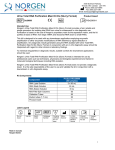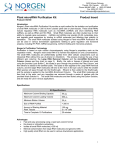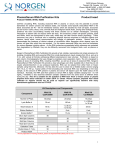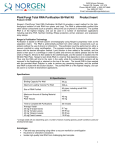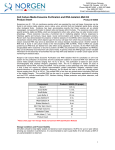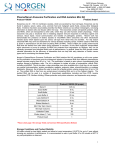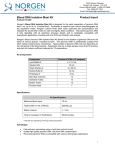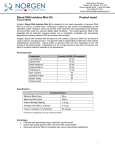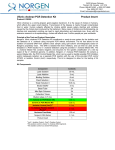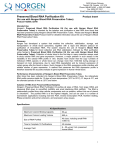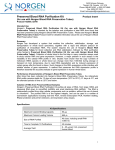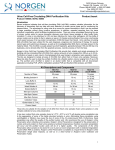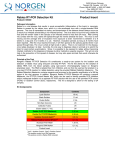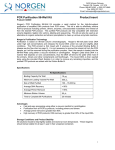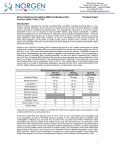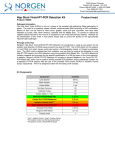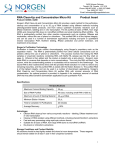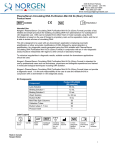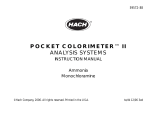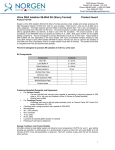Download Protocol (96-well) - Norgen Biotek Corp.
Transcript
3430 Schmon Parkway Thorold, ON, Canada L2V 4Y6 Phone: 866-667-4362 (905) 227-8848 Fax: (905) 227-1061 Email: [email protected] Urine Total RNA Purification Maxi 96-Well Kit (Slurry Format) Product Insert Product # 29650 Norgen’s Urine Total RNA Purification Maxi 96-Well Kit (Slurry Format) provides a rapid method for the isolation and purification of total RNA from 3 - 5 mL of urine. The kit purifies all sizes of RNA, from large mRNA and ribosomal RNA down to small RNAs. These small RNAs include regulatory RNA molecules such as microRNA (miRNA) as well as tRNA and 5S rRNA. Small RNA molecules are often studied due to their ability to regulate gene expression. miRNAs are typically 20-25 nucleotides long, and regulate gene expression by binding to mRNA molecules and affecting their stability or translation. Several recent studies showed that miRNA regulates cell growth and apoptosis. Furthermore, clinical and experimental analyses suggested that miRNAs may function as a novel class of oncogenes or tumor suppressor genes. MicroRNA expression profiles of different tumor types, relative to their normal tissues, have recently been shown to provide phenotypic signatures for particular cancer types. Unique patterns of aberrant miRNA expression may serve as molecular biomarkers for tumor diagnosis, prognosis of disease- specific outcomes, and prediction of therapeutic responses Purification is based on 96-well chromatography using Norgen’s proprietary resin as the separation matrix. The purification could be performed on either a vacuum manifold or using centrifugation. Norgen’s resin binds RNA in a manner that depends on ionic concentrations. The RNA is preferentially purified from other cellular components such as proteins, without the use of phenol or chloroform. The purified RNA is of the highest integrity, and can be used in a number of downstream applications including real time PCR, reverse transcription PCR, Northern blotting, RNase protection and primer extension, and expression array assays. This kit is designed to process 96 samples of 3-5 mL urine. Kit Components: Component Contents Slurry C3 2 x 24 mL Lysis Buffer A 4 x 130 mL Wash Solution A 2 x 20 mL Elution Solution A 2 x 6 mL 96-Well Filter Plate 1 Adhesive Tape 1 96-Well Collection Plate 1 96-Well Elution Plate 1 Product Insert 1 Customer-Supplied Reagents and Equipment For Vacuum Format: o Vacuum manifold with vacuum pump capable of generating a minimum pressure of 650 mbar or -25 in. Hg (such as Whatman UniVac 3 Vacuum to Collect Manifold) o Sealing tape or pads For Centrifuge Format: o Centrifuge with rotor for 96-well plate assembly (such as Thermo Fisher IEC Centra CL3 series or Beckman GS-15R) Centrifuge with a swinging bucket rotor capable of 2000 RPM Micropipettors 96 – 100% ethanol β-mercaptoethanol 15 mL tubes 1 Storage Conditions and Product Stability All buffers should be kept tightly sealed and stored at room temperature (15-25oC) for up to 1 year without showing any reduction in performance. It is recommended to warm up Slurry C3 and Lysis Buffer A for 20 minutes at 60oC if any salt precipitation (crystallization) is observed and mix well until the solution becomes clear again. (Note: Slurry C3 contains grey resin that will not disappear by warming up) Quality Control In accordance with Norgen’s Quality Management System, each lot of Norgen’s Urine Total RNA Purification Maxi 96-Well Kit (Slurry Format) is tested against predetermined specifications to ensure consistent product quality. Product Use Limitations Norgen’s Urine Total RNA Purification Maxi 96-Well Kit (Slurry Format) is designed for research purposes only. It is not intended for human or diagnostic use. Product Warranty and Satisfaction Guarantee NORGEN BIOTEK CORPORATION guarantees the performance of all products in the manner described in our product manual. The customer must determine the suitability of the product for its particular use Safety Information Ensure that a suitable lab coat, disposable gloves and protective goggles are worn when working with chemicals. For more information, please consult the appropriate Material Safety Data Sheets (MSDSs). These are available as convenient PDF files online at www.norgenbiotek.com. CAUTION: DO NOT add bleach or acidic solutions directly to the sample-preparation waste. Lysis Buffer A contains guanidinium salts, and should be handled with care. Guanidinium salts form highly reactive compounds when combined with bleach, thus care must be taken to properly dispose of any of these solutions Working with RNA RNases are very stable and robust enzymes that degrade RNA. Autoclaving solutions and glassware is not always sufficient to actively remove these enzymes. The first step when preparing to work with RNA is to create an RNase-free environment. The following precautions are recommended as your best defence against these enzymes. The RNA area should be located away from microbiological work stations Clean, disposable gloves should be worn at all times when handling reagents, samples, pipettes, disposable tubes, etc. It is recommended that gloves are changed frequently to avoid contamination There should be designated solutions, tips, tubes, lab coats, pipettes, etc. for RNA only All RNA solutions should be prepared using at least 0.05% DEPC-treated autoclaved water or molecular biology grade nuclease-free water Clean all surfaces with commercially available RNase decontamination solutions When working with purified RNA samples, ensure that they remain on ice during downstream applications Procedure Notes prior to use: We recommend the use of Norgen’s Urine Preservative when collecting urine samples, which is designed for the preservation of nucleic acids and proteins in fresh urine samples at ambient temperatures. The components of the Urine Preservative allow samples to be stored for over 2 years at room temperature with no detected degradation of urine DNA, RNA or proteins. Norgen’s Urine Preservative is available in 2 convenient formats: in a liquid format in Norgen’s Urine 2 Preservative Single Dose Ampules, as well as in a dried format in Norgen’s Urine Collection and Preservation Tubes. Please see the Related Products table below. Do not spin down or filter the urine sample before proceeding with the isolation, as this could decrease the RNA yield. All centrifugation steps are performed at room temperature. A variable speed centrifuge should be used for maximum kit performance. If a variable speed centrifuge is not available a fixed speed centrifuge can be used, however reduced yields may be observed. Ensure that all solutions are at room temperature prior to use. If precipitates (crystallization) are present in the Lysis Buffer A or in Slurry C3 it is highly recommended to warm up the Lysis Buffer A or in Slurry C3 at 60 oC for 20 minutes and mix well until the solution becomes clear again. (Note: Slurry C3 contains grey resin that will not disappear by warming up) The use of β-mercaptoethanol in lysis is highly recommended to isolate RNA for sensitive downstream applications. Add 10 µL of β-mercaptoethanol (provided by the user) to each 1 mL of Lysis Buffer A required. β-mercaptoethanol is toxic and should be dispensed in a fume hood. Prepare a working concentration of the Wash Solution A by adding 80 mL of 96-100% ethanol (provided by the user) to each supplied bottle containing the concentrated Wash Solution A. This will give a final volume of 100 mL. The labels on the bottles have a box that may be checked to indicate that the ethanol has been added. The minimum recommended urine input is 3 mL and the maximum recommended urine input is 5 mL. It is important to work quickly during this procedure. Urine inputs of 3 to 5 mL can be processed using either a vacuum manifold (Section A) or centrifugation (Section B). Note: This procedure as written is for processing 5mL urine samples. To process different urine volumes, please check Table 1 for the appropriate volumes of Lysis Buffer A and 96-100% Ethanol to be added to different urine sample volumes. The volume of Slurry C3 is fixed for all urine volumes A. Detailed Procedure Using Vacuum Manifold 1. Aliquot a 5 mL urine sample into a 50 mL conical tube. Add 0.35 mL Slurry C3 and 4.65 mL of Lysis Buffer A directly to the urine. Lyse cells by vortexing for 15 seconds. (Note: Slurry C3 contains resin and must be mixed well before every pipeting) 2. Add 5 mL of 96 - 100% ethanol (provided by the user) to the lysate. Mix by vortexing for 10 seconds. 3. Centrifuge for 5 minutes at 2,000 x g. Discard the supernatant. 4. Add 500 µL Wash Solution A, mix well by pipeting or vortexing. 5. Assemble the 96-Well Filter Plate and the vacuum manifold according to manufacturer’s recommendations. (Note: The provided 96-Well Collection Plate can be used as the collection/waste tray if desired). 6. Transfer the mixture from Step 4, including all resin, into a well of the 96- Well Filter Plate. 7. Tape the plate or any unused wells using sealing tape or pads (provided by the user) according to the vacuum manifold manufacturer’s recommendations. Apply vacuum for 4 minutes. Turn off vacuum and ventilate the manifold. Discard the flowthrough. Reassemble the 96-Well Filter Plate and the vacuum manifold. 3 8. Apply 500 µL of Wash Solution A to each used well of the 96-Well Filter Plate. Tape the plate or any unused wells using sealing tape or pads (provided by the user) according to the vacuum manifold manufacturer’s recommendations. Apply vacuum for 3 minutes. Turn off vacuum and ventilate the manifold. Discard the flowthrough. 9. Repeat Step 8 to wash the plate a third time. 10. Pat the bottom of the 96-Well Filter Plate dry. Reassemble the 96-Well Filter Plate and the vacuum manifold. Apply vacuum for an additional 5 minutes in order to completely dry the plate. Turn off vacuum and ventilate the manifold. 11. Replace the collection/waste tray in the vacuum manifold with a provided 96-Well Elution Plate. Complete the vacuum manifold assembly with the 96-Well Filter Plate. Add 50-100 µL of Elution Solution A to each used well of the plate. Apply vacuum for 3 minutes. Urine Total RNA is now ready for downstream applications. B. Detailed Procedure Using Centrifugation 1. Aliquot a 5 mL urine sample into a 50 mL conical tube. Add 0.35 mL Slurry C3 and 4.65 mL of Lysis Buffer A directly to the urine. Lyse cells by vortexing for 15 seconds. (Note: Slurry C3 contains resin and must be mixed well before every pipeting) 2. Add 5 mL of 96 - 100% ethanol (provided by the user) to the lysate. Mix by vortexing for 10 seconds. 3. Centrifuge for 5 minutes at 2,000 x g. Discard the supernatant. 4. Add 500 µL Wash Solution A, mix well by pipeting or vortexing. 5. Place the 96-Well Filter Plate on top of a provided 96-Well Collection Plate. 6. Transfer the mixture from Step 4, including all resin, into a well of the 96- Well Filter Plate. 7. Centrifuge the assembly at maximum speed or 2,000 RPM for 2 minutes. Discard the flowthrough. Reassemble the 96-Well Filter Plate and the 96-Well Collection Plate. 8. Apply 500 µL of Wash Solution A to each used well of the 96-Well Filter Plate. Centrifuge the assembly at maximum speed or 2,000 RPM for 2 minutes. Discard the flowthrough. Reassemble the 96-Well Filter Plate and the bottom plate. Note: Ensure the entire Wash Solution A has passed through into the bottom plate by inspecting the 96-Well Filter Plate. If the entire wash volume has not passed, centrifuge for an additional 2 minutes. 9. Repeat Step 8 to wash the plate a third time. 10. Pat the bottom of the 96-Well Filter Plate dry. Reassemble the 96-Well Filter Plate and the bottom plate. Centrifuge the assembly at maximum speed or 2,000 RPM for 5 minutes in order to completely dry the plate. 11. Stack the 96-Well Filter Plate on top of one of the provided 96-Well Elution Plates. Add 50-100 µL of Elution Solution A to each used well of the plate. Centrifuge the assembly at maximum speed or 2,000 RPM for 2 minutes. Urine Total RNA is now ready for downstream applications. 4 Table 1. Slurry C3, Lysis Buffer A and 96-100% Ethanol to be added to different Urine sample volumes Sample Volume (mL) Slurry C3 (mL) (Step 1) Lysis Buffer A (mL) (Step 1) 96-100% Ethanol (mL) (Step 2) 3 3.5 4 4.5 5 0.35 0.35 0.35 0.35 0.35 2.65 3.15 3.65 4.15 4.65 3 3.5 4 4.5 5 Frequently Asked Questions 1. If I am not going to process my samples immediately, how should I store my samples? We recommend the use of Norgen’s Urine Preservative when collecting urine samples, which is designed for the preservation of nucleic acids and proteins in fresh urine samples at ambient temperatures. Urine samples in the preservative should be stored at room temperature. Turbidity or precipitation may be observed if the urine samples are stored at either 4C or at -20C. DO NOT discard this precipitate and/or spin down your samples to get rid of the turbidity; this will significantly reduce your DNA yields. Make sure to mix your samples thoroughly before processing. 2. What If a variable speed centrifuge is not available? A fixed speed centrifuge can be used, however reduced yields may be observed. 3. What will happen if my centrifugation speed varied from the recommended speed? This may decrease the binding of the RNA to the column. 4. At what temperature should I centrifuge my samples? All centrifugation steps are performed at room temperature. Centrifugation at 4C will not adversely affect kit performance. 5. My centrifuge speeds are defined in rpm and not in g-force. How can I convert g-force to rpm? The correct rpm can be calculated using the formula: RPM = RCF (1.118 x 10-5) (r) Where RCF = required gravitational acceleration (relative centrifugal force in units of g); r = radius of the rotor in cm; and RPM = the number of revolutions per minute required to achieve the necessary g-force. 6. Can I process a different urine volume? Yes, you can. To process different urine volumes (up to 5mL) please check Table 1 for the appropriate volumes of Lysis Buffer A and 96-100% Ethanol to be added to different urine sample volumes. The volume of Slurry C3 is fixed for all urine volumes. The minimum recommended urine input is 3 mL, and the maximum recommended input is 5 mL. 7. What if I added more or less from the specified reagents’ volume? Adding less volume may reduce your RNA yields. Adding more may not affect the RNA yields EXCEPT if more Elution Solution A was added. Eluting RNA in a higher volume of Elution Solution A will result in diluting your RNA. 8. What if I forgot to do a dry spin after my third wash? Your RNA elution will be contaminated with traces of the Wash Solution A. This may dilute the RNA yield in elution. Also, it may interfere with your downstream applications. Re-isolate the eluted RNA using the same procedure as you initially isolated the RNA from urine but using your elution as your input. 9. Why did my samples show very low RNA yields? Some urine samples contain very little RNA. This varies from individual to individual based on numerous variables. In order to increase the yield, the amount of urine input could be increased. 5 10. Why does my RNA not perform well in downstream applications? If a different Elution solution was used other than the one provided in the kit, the buffer should be checked for any components that may interfere with the application. Common components that are known to interfere are high salts (including EDTA), detergents and other denaturants. Check the compatibility of your elution buffer with the intended use. 11. What is the expected RNA yield from urine? Normally the urinary RNA yield varies between individual samples depending on a number of factors such as time of sample collection, age, sex, diet, etc. Sometimes the RNA yields from urine are too low to be visualized on an agarose gel or to be quantified by regular spectrophotometric methods; however, the RNA yield is sufficient for most of the downstream applications including RT-PCR and Southern hybridization. 12. Why is the 96-Well Plate was clogged during vacuuming? This indicates an insufficient vacuum. Ensure that a vacuum pressure of at least -650 mbar or -25 in. Hg is developed. Related Products Product # Urine Collection and Preservation Tubes (50 cc) – 1 tube 18111 Urine Collection and Preservation Tubes (50 cc) – 50 tubes 18113 Urine Collection and Preservation Tubes (15 cc) – 1 tube 18120 Urine Collection and Preservation Tubes (15 cc) – 50 tubes 18122 Urine Collection and Preservation Tubes (5 cc) – 1 tube 18116 Urine Collection and Preservation Tubes (5 cc) – 50 tubes 18118 Urine Preservative Single Dose – 1 tube 18124 Urine Preservative Single Dose – 50 tubes 18126 Urine microRNA Purification Kit 29000 Urine Collection and Preservation Tube 18111 Technical Assistance NORGEN’s Technical Service Department is staffed by experienced scientists with extensive practical and theoretical expertise in sample and assay technologies and the use of NORGEN products. If you have any questions or experience any difficulties regarding Norgen’s Urine Total RNA Purification Maxi 96-Well Kit (Slurry Format) or NORGEN products in general, please do not hesitate to contact us. NORGEN customers are a valuable source of information regarding advanced or specialized uses of our products. This information is helpful to other scientists as well as to the researchers at NORGEN. We therefore encourage you to contact us if you have any suggestions about product performance or new applications and techniques. For technical assistance and more information, please contact our Technical Support Team between the hours of 8:30 and 5:30 (Eastern Standard Time) at (905) 227-8848 or Toll Free at 1-866-667-4362. or call one of the NORGEN local distributors (www.norgenbiotek.com) or through email at [email protected]. 3430 Schmon Parkway, Thorold, ON Canada L2V 4Y6 Phone: (905) 227-8848 Fax: (905) 227-1061 Toll Free in North America: 1-866-667-4362 ©2014 Norgen Biotek Corp. PI29650-1-M14 6






